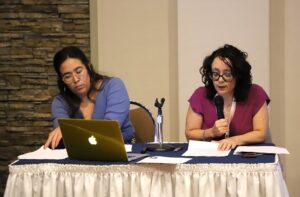Neonatal Abstinence Syndrome addressed at Anishinabek Nation Health Conference

By Jesse Johnson
NORTH BAY – Dr. Astrid Guttmann, a general paediatrician and Senior Scientist at the Hospital for Sick Children, and her team spoke about Neonatal Abstinence Syndrome and leveraging community strengths to address prenatal opioid exposure at the 9th annual Anishinabek Nation Health Conference on Oct. 18 in North Bay, Ont.
Prenatal opioid exposure and neonatal abstinence syndrome have had a big impact on First Nations. Institute for Clinical Evaluative Sciences (ICES) and Child-Bright Network are working together with 13 First Nations in the lower half of Ontario. This project came about when communities raised concerns about the health of school-aged children with prenatal opioid exposure.
The project’s goal is to build strong relationships with First Nations while gathering and sharing community and culturally-specific information about the impacts of prenatal opioid exposure and neonatal abstinence syndrome.
Opioids are drugs that are used primarily to treat pain. They can be attained by getting a prescription (Codeine, Fentanyl patch, Morphine, Oxycodone, etc.) or non-prescription (Heroin, Fentanyl). Synthetic opioids can be 50-100 times more potent than morphine.
“Since the COVID-19 pandemic, there has been an opioid crisis in Canada and a substantial increase in prenatal opioid exposure,” says Dr. Guttmann.
Neonatal Abstinence Syndrome (NAS) is a withdrawal syndrome sometimes seen in babies of mothers who used opioids (prescribed or illicit) or were treated for opioid-use disorder during pregnancy.
“Developmental concerns seen in children exposed to opioids could be related to other prenatal exposures such as alcohol, as well as, the social issues that lead mothers to use opioids,” she says.
She then spoke about the long-term impacts of prenatal opioid exposure.
“Recent research has shown that children born to mothers who use opioids during pregnancy can experience challenges related to prematurity at birth; behaviour problems; learning disabilities; mental health problems; speech and language problems, etc.,” Dr. Guttmann says. “There’s no clear scientific consensus on the extent to which prenatal opioid exposure solely explains these outcomes. Emerging clinical guidelines suggest enhanced developmental monitoring of children with prenatal opioid exposure.”
She also shared some statistics about prenatal opioid exposure.
“10.2 per cent of babies born between 2013 and 2019 had prenatal opioid exposure,” she says. “So that is 279 babies over a seven-year period. The percentage of babies with prenatal opioid exposure increased for the 13 First Nations between 2013 and 2015 and then decreased considerably thereafter.”
She then spoke about the challenges babies could face while having prenatal opioid exposure.
“Compared to babies without prenatal opioid exposure were more likely to be born early (before 37 weeks gestation); need a higher level of care (neonatal intensive care unit); longer hospital stay (six vs three days); and, they could be removed from their mother’s care at birth.”
Dr. Guttmann’s team spoke about the support that comes from the community and its members.
“Support comes from the passionate and strong people working to make positive changes; programs such as Healthy Babies Healthy Children; daycares; Jordan’s Principle; and supportive community leaders,” she says.
For more information on the 9th annual Anishinabek Nation Health Conference, visit www.anishinabek.ca.


